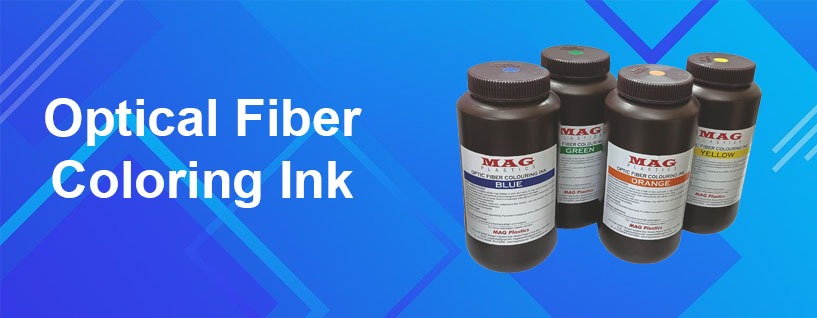Optical fiber coloring ink is used to color code individual fibers within an optical fiber cable. This color coding is essential for identifying and managing the different fibers within a cable, especially in situations where multiple fibers are bundled together. The color code helps in the installation, maintenance, and troubleshooting of fiber optic networks. Here are some common color codes used for optical fibers:
1. Single-mode Fibers: Blue – Yellow
2. Multimode Fibers: Orange – Aqua
3. Additional Colors (for large fiber count cables): Green – Brown – Slate/Gray -White – Red – Black – Yellow
Each color corresponds to a specific fiber within the cable. The order and pattern of colors are standardized to ensure consistency across different installations. The color codes are typically defined by industry standards, such as those established by the Telecommunications Industry Association (TIA) or the International Electrotechnical Commission (IEC). The coloring is usually applied to the fibers during the manufacturing process using color coating or ink. The coloring is carefully controlled to ensure that it does not interfere with the performance of the fiber. The outer color coating does not affect the transmission properties of the core. It’s important to adhere to industry standards for fiber optic color coding to maintain consistency and facilitate easy identification during installation, maintenance, and repairs. Optical fiber coloring ink is used in the telecommunications industry to color-code individual fibers within an optical fiber cable. These color codes help technicians and installers identify and manage the fibers during installation, maintenance, and troubleshooting. The coloring of optical fibers is crucial for ensuring accuracy and efficiency in fiber optic networks. Here are some key points about optical fiber coloring ink:
1. Identification Purpose: Optical fiber coloring ink is applied to the buffer coating of individual fibers. The colors are standardized to represent specific functions or positions within a cable.
2. Color Coding Standards: There are industry standards that define the color codes for optical fibers. The most commonly used standard is the TIA/EIA-598 standard in the United States. This standard specifies color codes for individual fibers, typically using colors like blue, orange, green, brown, slate, white, red, black, yellow, violet, rose, and aqua.
3. Permanent and Stable: The coloring ink used on optical fibers is designed to be permanent, stable, and resistant to environmental factors. It should not degrade or fade over time.
4. Application Process: The coloring ink is applied during the manufacturing process of the optical fiber. The ink is typically coated onto the fiber’s buffer layer.
5. UV-Curable Inks: UV-curable inks are often used for coloring optical fibers. These inks can be rapidly cured using ultraviolet (UV) light, providing a quick and efficient coloring process.
6. High Precision: The application of coloring ink requires high precision to ensure accurate color-coding. This precision is crucial for maintaining the integrity and functionality of the optical fiber.
7. Testing and Quality Control: Optical fiber manufacturers conduct rigorous testing and quality control procedures to ensure that the coloring process meets industry standards. This includes verifying color accuracy and stability.
8. Compliance with Regulations: Optical fiber coloring ink must comply with relevant regulations and standards to ensure compatibility with the optical fiber cable and its applications. It’s important to note that the specific practices and color-coding standards may vary by region and among manufacturers, so it’s essential to refer to the applicable industry standards and guidelines for accurate information.

